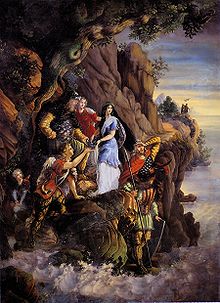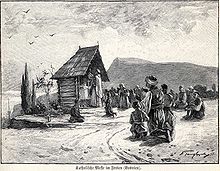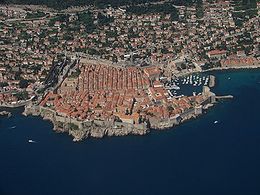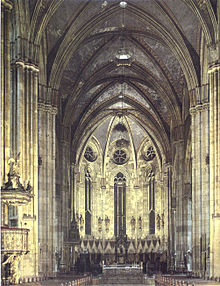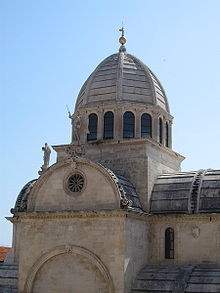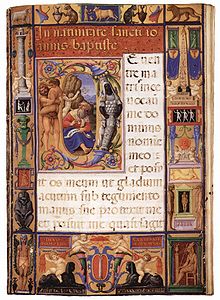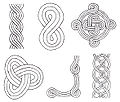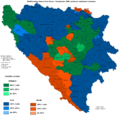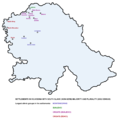- Croats
-
Croats
Hrvati


 Tomislav
Tomislav


 Ruđer Bošković
Ruđer Bošković







Total population c. 8.5 million (est.) [1] Regions with significant populations  Croatia 3,977,171[2]
Croatia 3,977,171[2]
 Bosnia and Herzegovina 659,718 (2009)[3]
Bosnia and Herzegovina 659,718 (2009)[3] United States
United States420,763 (2007) [4]  Chile
Chile380,000 [5]  Argentina
Argentina250,000 [5]  Germany
Germany227,510 [5]  Austria
Austria150,719 [6]  Australia
Australia118,046 (2006) [7]  Canada
Canada110,880 [8]  Peru
Peru88,512 [9]  Serbia
Serbia70,602 [10]  Brazil
Brazil45,000 (est.) [5]  Switzerland
Switzerland40,484 (2006) [11]  Slovenia
Slovenia35,642 (2002) [12]  France
France30,000 (est.) [13]  Hungary
Hungary25,730 [14]  Italy
Italy21,360 [15]  South Africa
South Africa8,000 [16]  Montenegro
Montenegro6,811 (2000) [17]  Romania
Romania6,786 [18]  Sweden
Sweden6,063 [19]  Denmark
Denmark5,400 [20]  Norway
Norway3,909 [21]  Belgium
Belgium810 [22] Languages Religion predominantly Roman Catholic
Related ethnic groups Other Slavs, especially other South Slavs
Serbs, Bosniaks, Montenegrins and Slovenes are the most related[23]Croats (Croatian: Hrvati) are a South Slavic ethnic group mostly living in Croatia, Bosnia and Herzegovina and nearby countries. There are around 4 million Croats living inside Croatia and up to 4.5 million throughout the rest of the world.[1][24] Responding to political, social and economic pressure, many Croats have migrated throughout the world, and established a notable Croatian diaspora. Large Croat communities exists in The United States, Chile, Argentina, Germany, Austria, Australia, Bolivia, Canada, Serbia, New Zealand and South Africa. Croats are noted for their culture, which has been influenced by a number of other neighbouring cultures through the ages. The strongest influences came from Central Europe and the Mediterranean where, at the same time, Croats have made their own contribution. The Croats are predominantly Catholic with minor groups of Protestants, Muslims, Orthodox, Jews and secular non religious atheists, agnostics and their language is Croatian.
Contents
Locations
Croatia is the nation state of the Croats, while in the adjacent Bosnia and Herzegovina they are one of the three constituent peoples alongside Bosniaks and Serbs.
Native Croat minorities exist in or among:
- Vojvodina, the northern autonomous province of Serbia, where the Croatian language is official (along with five other languages); the vast majority of the Šokci consider themselves Croats, as well as many Bunjevci (the latter, as well as other nationalities, settled the vast, abandoned area after the Ottoman retreat; this Croat subgroup originates from the south, mostly from the region of Bačka).
- The Šokci and Bunjevci communities in Bács-Kiskun county in Hungary.
- Croats are a recognized people in Montenegro, where the Croatian language is in use; they mostly live in the Bay of Kotor.
- a very small community in the Carso and Trieste area, in Italy. This is the northwesternmost area populated by Croats. They are mostly assimilated, but traces remain in surnames and some place names.
- Primorska, Prekmurje and in the Metlika area in Dolenjska regions in Slovenia.
- Zala, Baranya and Somogy counties in Hungary, which are border areas with Croatia.
- Krashovans in Romania mostly consider themselves Croatian - see Croats of Romania.
- Burgenland in the eastern part of Austria and the bordering areas of western Hungary (the counties of Vas and Győr-Moson-Sopron) and Slovakia - the Croats of Gradišće - Burgenland Croats.
- Kosovo - Janjevci (Letničani).
- Molise area in Italy - Molise Croats.
- Szentendre town in Hungary, magyarized, but preserving a memory of their Croat origins (from Dalmatia).
- The area around Bratislava in Slovakia: the villages of Chorvátsky Grob, Čunovo, Devínska Nová Ves, Rusovce and Jarovce. Most have assimilated, but a small minority still preserves its Croatian identity.
- The Moravia region in the Czech Republic. The villages of Jevišovka (Frielištof), Dobré Pole (Dobro Polje) and Nový Přerov(Nova Prerava).[citation needed]}
The population estimates are reasonably accurate domestically: around four million in Croatia and nearly 600,000 in Bosnia and Herzegovina, or 15% of the total population.
Diaspora
A large number of Croats were forced to leave their traditional homeland over the course of time for economic or political reasons. Thus today there exists quite a large Croat diaspora outside their traditional homeland in southern Central Europe.
The first large emigration of Croats took place in the 15th and 16th centuries, at the beginning of the Ottoman conquests in today's Croatia, Bosnia and Herzegovina. People fled to safer areas in what are today Croatia, and other areas of the Habsburg Empire, today's Czech Republic, Slovakia, Austria, Hungary, Slovenia, Croatia and small parts of Italy, Germany and the Ukraine. This migration resulted in Croat communities in Austria and Hungary.
At the end of the 19th and the beginning of the 20th century, larger numbers of Croats emigrated, particularly for economic reasons, to overseas destinations. These included North America (Croatian American and Canadians of Croatian ancestry); South America, above all Chile (Croatian Chilean) and Argentina (Croatian Argentine) with smaller communities in Bolivia and Peru; Australia and New Zealand; and South Africa.
A further, larger wave of emigration, this time for political reasons, took place immediately after the end of the Second World War. At this time, both collaborators of the Ustaša regime and refugees who did not want to live under a communist regime fled the country.
In the second half the 20th century numerous Croats left the country as immigrant workers, particularly to go to Germany, Austria, and Switzerland. In addition, some emigrants left for political reasons. This migration made it possible for communist Yugoslavia to achieve lower unemployment and at the same time the money sent home by emigrants to their families provided an enormous source of foreign exchange income. During this period, tens of thousands of Croats also emigrated to neighboring Slovenia; to this day, Croats of Slovenia represent the second largest ethnic group in the country after the Slovenes.
The last large wave of Croat emigration occurred during and after the Yugoslav Wars, when many people from the region (not only Croats but Serbs, Bosniaks and others) left as refugees. Migrant communities already established in countries such as Australia, the USA, and Germany grew as a result.
Abroad, the count is approximate because of incomplete statistical records and naturalization, but the highest estimates suggest that the Croatian diaspora numbers as much as a third[25] and a half[24] of the total number of Croats. The largest emigrant groups are in Western Europe, mainly in Germany, where it is estimated that there are around 450,000 people with direct Croatian ancestry.
Overseas, the United States contains the largest Croatian emigrant group (544,270 in the 1990 census; 374,271 in the 2000 census), mostly in Ohio, Pennsylvania, Illinois and California, with a sizable community in Alaska, followed by Australia (105,747 according to 2001 census, with concentrations in Sydney, Melbourne and Perth) and Canada (Southern Ontario, British Columbia, Alberta and Newfoundland). Croats have also emigrated in several waves to Latin America, mostly to South America: chiefly Chile, Argentina, and Brazil; estimates of their number vary wildly.[5][26][27] There are also smaller groups of Croatian descendants in the UK, France, Romania, Sweden, Netherlands, Spain, Brazil, Mexico, Russia and South Korea. The most important organizations of the Croatian diaspora are the Croatian Fraternal Union, Croatian Heritage Foundation and the Croatian World Congress.
Origins
Part of a series of articles on Croats  RecognizedSubgroupsArrival of the Croats to Dalmatia during the 7th century; romantic portrayal by Ferdinand Quiquerez.
RecognizedSubgroupsArrival of the Croats to Dalmatia during the 7th century; romantic portrayal by Ferdinand Quiquerez.
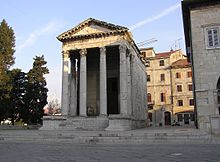 Temple of Augustus (Pula):
Temple of Augustus (Pula):
"ROMAE · ET · AUGUSTO · CAESARI · DIVI · F · PATRI · PATRIAE" - "Roma and Augustus Caesar, son of the deity, father of the fatherland"The origin of the Croatian tribe before the great migration of the Slavs is uncertain. According to the most widely accepted[28] Slavic theory concerning the migrations of the 7th century, the Croatian tribe moved from the area north of the Carpathians and east of the river Vistula (referred to as White Croatia) and migrated into the western Dinaric Alps. White Croats formed the Principality of Dalmatia in the upper Adriatic. Another[citation needed] wave of Slavic migrants from White Croatia subsequently founded the Principality of Pannonia. However, some scholars doubt the above theory, which is based primarily on De Administrando Imperio, a tenth-century work by Byzantine Emperor Constantine Porphyrogenitus. The doubt rests primarily on archaeological and historiographical grounds. In 603 AD, according to the codices of the church of Thessaloniki, Croats, who had invaded Dalmatia and Istria, have been confusing Maximus the bishop of Salona, because they wrote him back.[clarification needed][citation needed] He described the Croats as the "insightful" Slavs. According to a letter of Pope Gregory, the colonization by Slavs of Imperial estates in Istria, which were available to the public, was known since the 6th Century, but was still in the 9th Century on the agenda for a People's Assembly in Istria, which brought forth some very remarkable documents.[29] D.A.I. states that the Croats arrived during Heraclius' regnal years (610–640 AD) from "Bagibareja", which translated means that they arrived from "a prominent town". However, there is little archaeological supporting such a migration. Moreover, it is unlikely that any political entity such as White Croatia ever existed, because the justification for it is only in the clearly erroneous translation of the word Bagibareja.[30] Instead, Curta points to some burial assemblages in the northern Dalmatia region, which he dates to 800 AD. Here, there are some exceptionally rich burials showing Byzantine, Avar, Frankish and Slavic material elements, perhaps representing a "community of Croats". That is, Curta suggests that the Croats emerged as some kind of an elite caste of Slavic-speaking warriors, consequently spreading their influence, thus their name, over much of Dalmatia and parts of Pannonia. A theory of migration from the north to the south may be interpreted in this context as a philosophical balance with the propagation of the faith from the south to the north. Subsequent papal recognition ensured the evolution from "a prominent tribe" to a medieval kingdom. However, because of events such as the earthquakes between 350 and 450 AD, a migration theory cannot be ruled out; also because Ostrogorski[31] claims that the Slavs, who had tried to take Thessaloniki in 597, invaded Crete in 623, but the sources for his thesis are not clearly known, and because Alexandria was taken by Khosrau II of Persia in 616, but Heraclius recovered it a few years later. Here could be a link to the linguistic Persian theory, too.
According to the Gothic theory[citation needed], Croats would be descendants of Ostrogoths/eastern Goths. This theory is based on a historic chronicle from Thomas the Archdeacon called Historia Salonitana where he mentions Croats as Goths. Also, Slavs in the area of modern Croatia are equated to Goths in Chronicle of the Priest of Duklja. John of Nikiû described how Vitalian (general) was opposed by Marinus, who took all ships he could find and manned them with a large force of Scythian and Gothic archers and sailed in the direction of Byzantium, but he took to flight and the sailors sailed then to Dalmatia, where the origin of the word Župan was described in the year 1250 in a manuscript on Glagolitic alphabet on the island of Brač, because Croats are not only inhabitants of Croatia, they are also inhabitants of a župa. John of Nikiû used the term "Illyrians" who devastated Christian cities and carried off their inhabitants captive, and that no city escaped save except Thessalonica only. But that reminds on the history by Marcus Terentius Varro about Idomeneus, who during the Trojan War, after his return to Crete, sailed first to Illyria, and then together with Illyrians and Locrians to southern Italy.[32][33] Whereupon the Goths sacked Troja and Ilium, according to Jordanes. Snorri Sturluson claimed, that the Trojans made then a journey to Scandinavia. This could explain the Haplogroup, see below. There are different theories why the history repeats itself.[34] Wilhelm Max Müller mentioned in 1893 an inscription in Medinet Habu (temple), which mentions the "Hrv-š' " under the feets of Ramses III, who defeated the Sea Peoples.[35] After the victory over the Sea peoples, the Philistines were settled by Ramses III in the land of the Hrv-š' (or Hrjw-sch) whose Dukes became very frightened and brought him many tributes.[36] Another theory is since 1946 that the name Palaestīnī derives from the attested Illyrian locality Palaeste.[37]
According to the autochthonous model, mostly promoted by the Illyrian Movement in the 19th century and abandoned[28] by the mid-19th century, the Slav homeland is actually in the area of southern Croatia, and they spread northwards and westwards rather than the other way round. A revision of the theory, developed by Ivan Muzić[38] argues that Slav migration from the north did happen, but the actual number of Slavic settlers was small and that the Illyrian ethnic substratum was prevalent in the formation of Croatian ethnicity.
The Iranian theory suggests that the Croats are a tribe from Arachosia. This theory is based solely on linguistic evidence, namely the spread of the Old Croatian ethnonym *xъrvatъ, almost certainly a borrowing into Slavic, probably from the Middle Persian "harw, hrw", which means "all, each, every", from the Middle Persian "xwad, hwt", which means "self", or from the Sanskrit "kratu", which means "insightful"; and the use of the Sanskrit "Bagibareja", which means "a prominent town".
It is important to note[says who?] that 'origin' theories are often developed amidst a wider context of ideological-political discourse. Nevertheless the Gothic and Iranian origins theories have at times been supported by scholars such as Ivan Muzic. They represent an attempt to distance Croats from other Slavs, especially Serbs, during the volatile period of late 1970s until recently.[39]
For all the theories, the documentary and archaeological evidence is quite clear that the Croats emerged within ninth-century northern Dalmatia. At this time, there was no migration to account for, rather, political circumstances created a climate conducive to the emergence of a new polity in the northern Adriatic, between the Carolingian and Byzantine Empire. Ruled by local notables - the 'Croats' - the Croat ethonym later spread (and contracted) following the political fortunes of the Croat Kingdom. The creation of a Christianized Croat kingdom, recognized by Byzantium and the Papacy, cemented its existence and membership of a 'club' of European Christian Monarchic states.[40] As Danijel Dzino summarizes, "the question whether the Croats were migrants to Dalmatia or the indigenous population is not important. The earliest Croat identity we know of appeared with the disappearance of a structural Avar continuum and the establishment of new power structures in Dalmatia which were established on a new social and spiritual system from the West, indigenous regional polities - zupanias, and the use of the ancient past as a justification of that power". The Croats, based in the Nin-Knin-Skradin triangle, might have taken over local rule from an earlier socio-political collective- the Guduscani of Lika.
Genetics & Anthropology
Anthropologically, the craniometrical measurements made on the Croat population show Croats from Croatia are predominantly dolichocephalic, suggesting that they are more prone to dolichocephalic sub-racial types such as Nordic and Mediterranean than brachycephalic ones like Alpine and Dinaric.[41]
Croats from the northern regions generally have blonde-brown hair, and lighter eye colours, similar to the pigmentation of surrounding peoples such as Slovenians, Bosnians and Austrians. Croats from Dalmatia and Herzegovina generally have slightly darker hair, and higher incidence of brown eyes, although lighter hair and eyes are also common.
Genetically, on the Y chromosome line, a majority (>85%) of Croats belong to one of the three major European Y-DNA haplogroups - Haplogroup I (45%), Haplogroup R1a (27%) and Haplogroup R1b (13%).[42]
Later neolithic lineages which originated in the Middle East and brought agriculture to Europe, are present in surprisingly low numbers. The haplogroups J, E and T constitute together about 13% - significantly lower than other populations in the region.[42] The dominant presence of haplogroup I is rather interesting. This group exists only in Europe and is fairly widespread, but in relatively small percentages. Its frequency in the western Balkans is very high and the only population that has similar levels of the I group are the Scandinavians.[43] Haplogroup I among Croatians is divided in two major subdivisions[42] - I2a1 (33%), typical for the populations of eastern Adriatic and the Balkans, and I1 (9%), typical for north-western Europeans. Haplogroup I is believed to have weathered the last glacial maximum in the western Balkans, migrating north as the ice sheets retreated.
There are a number of relevant conclusions that can be drawn from the genetic data.
First of all it gives strong support to the theory that the region of modern day Croatia served as a refuge for northern populations during the last glacial maximum (LGM). The eastern Adriatic coast was much further south. The northern and western parts of that sea were steppes and plains, while the modern Croatian islands (rich in Paleolithic archeological sites) were hills and mountains. After the LGM, the offspring of these survivors (haplogroup I) repopulated much of central-eastern and southeastern Europe. Those who remained in the Balkans were the direct male-line ancestors of about 45% of modern day Croats in Croatia and 73% Croats in Herzegovina.[42]
It can be said that the Croats are "the most European people", as no other people have such a high share of this major (and probably the only) Paleolithic European haplogroup.
The second conclusion that can be drawn is that the theory of an Iranian origin[clarification needed]. Nonetheless Modern-day Iranians have a significantly different haplogroup distribution, although Iranic communities have lived in eastern Europe for centuries. The low frequency of Anatolian haplogroups suggests that agriculture spread into the region of Croatia primarily by way of cultural contact.[44]
And the third conclusion from the genetic evidence points to the fact Croats are genetically heterogeneous, pointing to a high degree of mixing of newly arrived medieval migrant tribes (such as Slavs) with the indigenous populations that were already present in the region of modern day Croatia.[45] Hence, most modern day Croats are directly descended from the original European population of the region who have lived in the territory by other names, such as Illyrians, and their forebears. These original inhabitants also served an important role in re-populating Europe after the last ice age.[42]
History
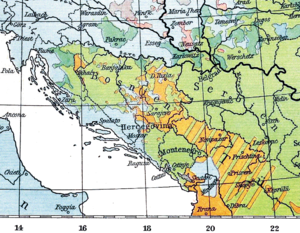 Map of demographic distribution of main religious confessions in Croatia, Dalmatia, Bosnia, Serbia and Montenegro in 1901:
Map of demographic distribution of main religious confessions in Croatia, Dalmatia, Bosnia, Serbia and Montenegro in 1901: CatholicMuslimOrthodoxProtestantMixed Catholic and OrthodoxMixed Catholic and Protestant
CatholicMuslimOrthodoxProtestantMixed Catholic and OrthodoxMixed Catholic and ProtestantThe earliest Croatian state was the Principality of Dalmatia. Prince Trpimir of Dalmatia was called Duke of Croats in 852. In 925 Croatian Duke of Dalmatia Tomislav of Trpimir united all Croats. He organized a state by annexing the Principality of Pannonia as well as maintaining close ties with Pagania and Zahumlje.
Since the creation of the personal union with Hungary in 1102, the Croats were at times subjected to enforced Germanization and Magyarization, especially from the 17th century onward.[46][47][48] The ensuing Ottoman conquests and Habsburg domination broke the Croatian lands into disunity again, with the majority of Croats living in Croatia proper and Dalmatia. Large numbers of Croats also lived in Slavonia, Istria, Rijeka, Herzegovina and Bosnia. Over the centuries ensued a wave of Croatian emigrants, notably to Molise in Italy, Burgenland in Austria and eventually the United States of America and Western Europe.
After the First World War, most Croats were united within the Kingdom of Serbs, Croats and Slovenes, created by joining South Slavic lands under the former Austro-Hungarian rule with the Kingdom of Serbia. Croats became one of the constituent nations of the new kingdom. The state was transformed into the Kingdom of Yugoslavia in 1929 and the Croats were united in the new nation with their neighbours – the South Slavs-Yugoslavs. In 1939, the Croats received a high degree of autonomy when the Banovina of Croatia was created, which united almost all ethnic Croatian territories within the Kingdom. In the Second World War, the Axis forces created the Independent State of Croatia led by the Ustaše movement which sought to create an ethnically pure Croatian state on the territory corresponding to present-day countries of Croatia and Bosnia and Herzegovina.
Post-war Socialist Federal Republic of Yugoslavia became a federation consisting of 6 republics, and Croats became one of two constituent peoples of two – Croatia and Bosnia and Herzegovina (in the latter one of the three since 1968). Croats in Serbian autonomous province of Vojvodina are one of six main ethnic groups composing this region.[49] Following the democratization of society, accompanied with ethnic tensions that emerged in the post-Tito era, in 1991 the Republic of Croatia declared independence, which was followed by war with its Serb minority, backed up by Serbia-controlled Yugoslav People's Army. In the first years of the war, over 200,000 Croats were displaced from their homes as a result of the military actions. In the peak of the fighting, around 550,000 ethnic Croats were displaced altogether during the Yugoslav wars.
Post-war government's policy of easing the immigration of ethnic Croats from abroad encouraged a number of Croatian descendants to return to Croatia. The influx was increased by the arrival of Croatian refugees from Bosnia and Herzegovina. After the war's end in 1995, most Croatian refugees returned to their previous homes, while some (mostly Croat refugees from Bosnia and Herzegovina and Janjevci from Kosovo) moved into the formerly-held Serbian housing.
Culture and traditions
The area settled by Croats has a large diversity of historical and cultural influences, as well as diversity of terrain and geography. The coastland areas of Dalmatia and Istria were subject to Roman Empire, Venetian and Italian rule; central regions like Lika and western Herzegovina were a scene of battlefield against the Ottoman Empire, and have strong epic traditions. In the northern plains, Austro-Hungarian rule has left its marks.
In spite of foreign rule, Croats developed a strong, distinctive culture and sense of national identity, a tribute to the centuries in which they remained distinct, avoiding assimilation of the overlords' population. The most distinctive features of Croatian folklore include klapa ensembles of Dalmatia, tamburitza orchestras of Slavonia. Folk arts are performed at special events and festivals, perhaps the most distinctive being Alka of Sinj, a traditional knights' competition celebrating the victory against Ottoman Turks. The epic tradition is also preserved in epic songs sung with gusle. Various types of kolo circular dance are also encountered throughout Croatia.
The Croatian language has a long written tradition with documents like Baška Tablet dating as early as 1100. The modern standard language is based on ijekavian shtokavian dialect. There are two other dialects, chakavian (spoken in Istria and Dalmatia) and kajkavian, (spoken in Zagorje and wider Zagreb area), which to an extent have been influenced and superseded by the standard, yet they still color the respective vernacular speeches. Despite that diversity, Croats take their language as a strong issue of national consciousness and are fairly negative towards foreign influences.
Croats are vastly Roman Catholic, and the church has had a significant role in fostering of the national identity. The confession played a significant role in the Croatian ethnogenesis.
Ragusan Republic and Dalmatia are the homeland of Croatian literature. It was developed largely in the renaissance period, with works of Dalmatian and Ragusan authors like Marko Marulić and Marin Držić, and continued through baroque with Ivan Gundulić, romanticism with Ivan Mažuranić and August Šenoa up to the modern days.
Art
In the 7th century the Croats, with other Slavs and Avars, came from Northern Europe to the region where they live today.[50] The Croats were open to Roman art and culture, and first of all to Christianity. The first churches [1] were built as royal sanctuaries, and the influences of Roman art were strongest in Dalmatia where urbanization was greatest, and where there were most monuments. Gradually, that influence diminished and there was a certain simplification and alteration of inherited forms; original buildings even appeared.
The largest and most complicated centrally based church from the 9th century is St Donatus in Zadar, for its time comparable only in its size and beauty with the chapel of Charlemagne in Aachen.
The altar enclosures and windows of these churches were highly decorated with transparent shallow string-like ornamentation called Croatian pleter (meaning 'to weed', because the strings were threaded and rethreaded through themselves). Some engravings appeared in early Croatian script – Glagolitic. Soon, Glagolitic writing was replaced with Latin on the altar boundaries and architraves of old-Croatian churches.
By joining the Hungarian state in the twelfth century, Croatia lost its independence, but it did not lose its ties with the south and the west, and instead this ensured the beginning of a new era of Central European cultural influence.
Early Romanesque art appeared in Croatia at the beginning of the 11th century, when the monasteries had become strongly developed and the church was undergoing reform. Many valuable monuments and artefacts were created along the Croatian coast, including the 13th century Cathedral of St. Anastasia, Zadar (in Croatian, St. Stošija).
In Croatian Romanesque sculpture there was a move away from decorative interlaced relief work (Croatian pleter) towards the figurative. The best examples of Romanesque sculpture are the wooden doors of Split cathedral by Andrija Buvina (c.1220) and the stone portal of Trogir cathedral by artisan Radovan (c. 1240).
Early frescoes are numerous and best preserved in Istria. In them can be seen evidence of the mix of influences from Eastern and Western Europe. The oldest miniatures are the 13th century gospels from Split( spalato) and Trogir( Traù).
Gothic art in the 14th century was supported by city councils, preaching orders (such as the Franciscans), and knightly culture. It was the golden age of the free Dalmatian cities as they engaged in trade with the Croatian feudal nobility on the continent. The largest urban project of the time was the complete construction of two new towns – Great and Little Ston and about a kilometre of wall with guard towers between them, after Hadrian's Wall in England the longest wall in Europe.
The Tatars destroyed the Romanesque cathedral in Zagreb during their scourge of 1240, but immediately after their departure the Hungarian king Bela IV granted Zagreb the title of Free City. Soon after, bishop Timotej began rebuilding the cathedral in the new Gothic style.
Zadar was an independent Venetian city. The most beautiful examples of Gothic humanism in Zadar are its gilded metal reliefs, such as the Arch of St Simon by a Milanese artisan of 1380.
Gothic painting is less well preserved, and the finest works are in Istria, such as the fresco-cycle of Vincent of Kastv in the Church of St. Mary in Škriljinah near Beram, from 1474. From that period also are two of the most ornately illuminated liturgies done by monks from Split, – Hvals’ Zbornik (now in Zagreb) and the Missal of Bosnian Duke Hrvoje Vukčić Hrvatinić (now in Istanbul).
In the 15th century, Croatia was divided among three states – northern Croatia was part of the Austrian Empire, Dalmatia (with the exception of Dubrovnik) was under the rule of the Venetian Republic and Slavonia was under Ottoman occupation. Dalmatia was on the periphery of several influences: religious and public architecture clearly influenced by the Italian renaissance flourished. Three works of that period are of European importance, and contributed to the further development of the Renaissance: the Cathedral of St. James in Šibenik, by Juraj Dalmatinac (1441); the Chapel of Blessed John of Trogir by Nicola Fiorentino (1468); and Sorkočević’s Villa in Lapad, near Dubrovnik (Ragusa) (1521).
In northwestern Croatia the outbreak of war with the Ottoman Empire caused many problems, but in the long term it reinforced the influence of the north, where the Austrians held power. With permanent danger from the Ottomans in the east, the influence of the Renaissance was modest, while fortifications proliferated, like the fortified city of Karlovac, built in 1579, and the Ratkay family's fort in Veliki Tabor, also from the 16th century.
Some famous Croatian Renaissance artists lived and worked in other countries, like the brothers Laurana (Vranjanin, Franjo and Luka), miniaturist Juraj Klović (also known as Giulio Clovio) and the famous mannerist painter Andrea Medulla (teacher of El Greco).
In the 17th and 18th centuries, Croatia was reunited with the parts of the country that had been occupied by the Venetian Republic and the Ottoman Empire. Reunification contributed to a sudden flourishing of the arts in every form.
Large fortifications, with radial plan, ditches and numerous towers were built because of the constant Ottoman threat. The two largest were Osijek and Slavonski Brod; later they become large cities. Urban planning in the baroque style was in evidence in numerous new towns such as Karlovac, Bjelovar, Koprivnica and Virovitica. Some old Dalmatian cities also had baroque towers and bastions incorporated in their walls, as in Pula, Šibenik and Hvar. The biggest baroque undertaking was in Dubrovnik in the 17th century, after the catastrophic earthquake of 1667 when almost the entire city was destroyed. Wall painting flourished all over Croatia, from the illusionist frescoes in the church of St. Mary in Samobor and the church of St Catherine[disambiguation needed
 ] in Zagreb to the Jesuit church in Dubrovnik. An exchange of artists between Croatia and other parts of Europe took place. The most famous Croatian painter was Federiko Benković, knows as Dalmatino, who worked almost his entire life in Italy, while an Italian – Francesco Robba, did the best baroque sculptures in Croatia.
] in Zagreb to the Jesuit church in Dubrovnik. An exchange of artists between Croatia and other parts of Europe took place. The most famous Croatian painter was Federiko Benković, knows as Dalmatino, who worked almost his entire life in Italy, while an Italian – Francesco Robba, did the best baroque sculptures in Croatia.The Romantic movement in Croatia, arriving from Austria and the north at the beginning of the 19th century, was sentimental, gentle and subtle.
At the end of the 19th century, the architect Herman Bolle undertook one of the largest projects of European historicism – a half-kilometer long neo-renaissance arcade with twenty domes at the Zagreb cemetery Mirogoj. At the same time the cities of Croatia underwent significant urban renewal.
A structure that emphasizes all three visual arts is the former building of the Ministry of Prayer and Education (the so-called Golden Hall) in Zagreb (by Bolle, 1895). Vlaho Bukovac brought the spirit of impressionism from Paris, strongly influencing Croatia's young artists, including those who worked on the Golden Hall). At the Millennium Exhibition in Budapest they overshadowed all other artistic traditions of Austro-Hungary.
The turbulent twentieth century re-oriented Croatia politically many times and affected it in many other ways, but this could not significantly alter its already unique position at the crossroads of many different cultures.
Naming system
Given names A child is given a first name chosen by their parents but approved by the godparents of the child (the godparents rarely object to the parents' choice). The given name comes first, the surname last, e.g. "Željko Ivković", where "Željko" is a first name and "Ivković" is a family name. Female names end with -a, e.g. Ivan -> Ivana. Popular names are mostly of Croatian (Slavic), Christian (Biblical), Greek and Latin origin. Croatian: Niko, Ivo, Zoran, Goran,Antun and Željko. Greek: Nikola, Petar and Filip. Biblical: Ivan, Petar, Franjo and Gabrijel, . Latin: Marko, Josip, Antonio, Emilijan. Surnames Most Croatian surnames (like Bosniak, Serbian and Montenegrin) have the surname suffix -ić (pronounced Croatian pronunciation: [itʲ] or [itɕ]). This is often transliterated as -ic or -ici. In English-speaking countries, Croatian names have often been transcribed with a phonetic ending, -ich or -itch. This form is often associated with Croats from before the early 20th century: hence Ivan Ivanković is usually referred to as Ivan Ivankovitch. The -ić suffix is a Slavic diminutive, originally functioning to create patronymics. Thus the surname Petrić signifies little Petar, similar to Mac ("son of") in Scottish & Irish, and O' (grandson of) in Irish names. Other common surname suffixes are -ov or -in which is the Slavic possessive case suffix, thus Nikola's son becomes Nikolin, Petar's son Petrov, Ivan's son Ivanov and son of son of Pavao would be Pavlović(Pavlov sin in Croatian). Those are more typical for Croats from Vojvodina, Bulgaria and minority in central Croatia. The two suffixes are often combined. The most common surnames are Horvat,Marković, Ivanković, Pavlović etc...
Croatian last names are very simillar to Serbian ones along with Bosniak, Montenegrin and Slovene. But most Croats had their last name before Serbs and Bosniaks due to Ottoman occupation of Serbia and Bosnia.
Symbols
The Flag of Croatia consists of a red-white-blue tricolor with the Coat of Arms of Croatia in the middle. The red-white-blue tricolor was chosen as these were the colours of Pan-Slavism, popular in the 19th Century.
The coat-of-arms consists of the traditional red and white squares or grb, which simply means 'coat-of-arms'. It has been used to symbolise the Croats for centuries; some speculate that it was derived from Red and White Croatia, historic lands of the Croatian tribe but there is no generally accepted proof for this theory. The current design added the five crowning shields which represent the historical regions from which Croatia originated.
The red and white checkerboard has been a symbol of Croatian kings since at least the 10th century, ranging in number from 3×3 to 8×8, but most commonly 5×5, like the current coat. The oldest source confirming the coat-of-arms as an official symbol is a genealogy of the Habsburgs dating from 1512 to 1518. In 1525 it was used on a votive medal. The oldest known example of the šahovnica (chessboard in Croatian) in Croatia is to be found on the wings of four falcons on a baptismal font donated by king Peter Krešimir IV of Croatia (1058–1074) to the Archbishop of Split.
Unlike in many countries, Croatian design more commonly uses symbolism from the coat-of-arms, rather than from the Croatian flag. This is partly due to the geometric design of the shield which makes it appropriate for use in many graphic contexts (e.g. the insignia of Croatia Airlines or the design of the shirt for the Croatia national football team), and partly to the fact that neighbouring countries like Slovenia and Serbia use the same Pan-Slavic colours on their flags as Croatia.
The Croatian wattle (pleter or troplet) is also a commonly used symbol which originally comes from monasteries built between the 9th and 12th century. The wattle can be seen in various emblems and is also featured in modern Croatian military ranks and Croatian police ranks insignia.
Maps
See also
- List of Croats
- Croatian diaspora
- Croatian literature
- Croatian Chilean
- Croatian Argentine
- Croatian Brazilian
- Croatian Australian
- Croatian Peruvian
- Croatian Greek Catholic Church
- Croatian Muslims
- Croatian Eastern Orthodox Christians
- Timeline of Croatian history
- List of Medieval Slavic tribes
References
Notes
- ^ a b Daphne Winland (2004), "Croatian Diaspora", in Melvin Ember, Carol R. Ember, Ian Skoggard, Encyclopedia of Diasporas: Immigrant and Refugee Cultures Around the World. Volume I: Overviews and Topics; Volume II: Diaspora Communities, 2 (illustrated ed.), Springer, p. 76, ISBN 0306483211, 9780306483219, http://books.google.com/books?id=7QEjPVyd9YMC, "It is estimated that 4.5 million Croatians live outside Croatia (...)"
- ^ 2001 Census. Also The Statistical Yearbook 2009. Stanovništvu -population, page 13, Državni zavoda za statistiku, Republic of Croatia
- ^ CIA World Factbook: Bosnia and Herzegovina 14.3% of a total population of 4,613,414 (July 2009 not including "Refugees and internally displaced persons" because they put Bosnian Croats together with other types.
- ^ S0201. Selected Population Profile in the United States, Population Group: Croatian (109-110), Data Set: 2007 American Community Survey 1-Year Estimates, Survey: American Community Survey.
- ^ a b c d e Diaspora Croata "Se estima que en Argentina viven alrededor de 250.000 personas de descendencia croata (actualmente en Argentina viven 8.000 croatas nacidos en Croacia). (...) Hoy día se estima que en Brasil viven entre 30 y 50 mil croatas. La mayor parte vive en San Pablo, mientras que existe también una pequeña colonia de emigrantes croatas en Rio de Janeiro (...) El Ministerio de Relaciones Exteriores de la República de Chile evalúa que en ese país actualmente viven 380.000 personas consideradas de ser de descendencia croata, lo que es un 2,4% de la población total de Chile. La mayor parte de esas personas se asimiló en la sociedad chilena."
- ^ Census 2001 "Tabelle 5: Bevölkerung nach Umgangssprache und Staatsangehörigkeit", page 60 "131,307 Croatians + 19,412 Burgenland Croats = 150,719. In the Austrian census, Burgenland Croats are separate from the main Croat group."
- ^ 2006 Census of Population and Housing. Australia (you have to look around for an excel file. The one I found was labelled as "20680-Ancestry by Country of Birth of Parents - Australia")
- ^ Ethnic Origin (247), Single and Multiple Ethnic Origin Responses (3) and Sex (3) for the Population of Canada
- ^ Croatian Peruvian
- ^ 2002 Census in Serbia
- ^ 2006 Figures page 68, Petra-P12, gives a 40,484 number. as of 2004 page 12 2.1.1. Ständige ausländische Wohnbevölkerung nach Nationalität 2001 - 2004, gives a 44,035 number
- ^ Slovenian census 2002
- ^ La Croatie. Population et religions Embassy of Croatia in France "Diaspora. Plus de 2 millions de Croates (originaires de Croatie et de Bosnie-Herzégovine) vivent à l'étranger Dans la deuxième moitié du XIXe siècle de nombreux Croates ont émigré sur d'autres continents. Leurs descendants sont aujourd'hui 1,3 million aux États-Unis, 150 000 au Canada, 250 000 en Australie. Plus récemment, beaucoup sont partis vers l'Europe occidentale, principalement l'Allemagne où ils sont 280 000, l'Autriche 40 000, la Suisse 35 000, la France quelque 30 000."
- ^ Hungary census
- ^ Foreingers in Italy
- ^ Croatians in South Africa and their clubs
- ^ Montenegrian census page 14 Population by national or ethnic affiliation - Review for Republic of Montenegro and municipalities
- ^ Census in Romania
- ^ By Ancestry 2008 "1.1.2 Population by country of birth 1900–2006" in page 6 says 6,063 and "1.1.3 Population by citizenship 1900–2006" in page 10 says 2,763
- ^ Denmark – People Groups
- ^ Statistics Norway - Persons with immigrant background by immigration category and country background. 1 January 2010
- ^ Croatians in Belgium
- ^ "Ethnologue - South Slavic languages". www.ethnologue.com. http://www.ethnologue.com/show_family.asp?subid=373-16. Retrieved 2011-02-08.
- ^ a b Hrvatski Svjetski Kongres, Croatian World Congress, "4.5 million Croats and people of Croatian heritage live outside of the Republic of Croatia and Bosnia and Herzegovina", also quoted here
- ^ Hrvati u svijetu[dead link], Croatian Radio Television archive
- ^ Croatian Heritage Foundation Većeslav Holjevac in his book Hrvati izvan domovine estimates the number of Croatian emigrants in South America at 180,000 in 1932.
- ^ Croatian Emigrant Adresary places the total number of Croats in South America as high as 500,000
- ^ a b O porijeklu Hrvata, Radoslav Katičić, re-published on hercegbosna.org website
- ^ Marges et "marches" médiévale, Volume 15 de Siècles: Cahiers du Centre d'histoire "espaces et cultures", Bruno Phalip, Presses Univ Blaise Pascal, 2002.(ISBN 9782845161887)
- ^ Florin Curta. Southeastern Europe in the early Middle Ages
- ^ Georgije Ostrogorski, Histoire de l'État byzantin, p.122, Payot, 1998 (ISBN 978-2-228-90206-9)
- ^ The philological museum, Volume 2, page 142, The Philological Museum, Julius Charles Hare, Printed by J. Smith for Deightons, 1832.
- ^ Operum quae exstant, p. 174, Marcus Terentius Varro, printed by Christophorus Raphelengius, 1601.
- ^ Why History Repeats Itself Or Are We Getting Anywhere, John G. Sims, Jr., John G. Sims Jr., Kessinger Publishing, 2005. ISBN 9781419181092
- ^ Asien und Europa nach altägyptischen Denkmälern, W. Max Müller, Seite 393, Verlag von Wilhelm Engelmann, Leipzig 1893.
- ^ Orte und Landschaften der Bibel: ein Handbuch und Studien-Reiseführer zum Heiligen Land, Seite 210, Band 1 von Orte und Landschaften der Bibel: Ein Handbuch und Studien-Reiseführer zum Heiligen Land, Christoph Uehlinger, Othmar Keel, Max Küchler, Vandenhoeck & Ruprecht, 1984. ISBN 9783545230446
- ^ Bonfante, G. (1946). "Who were the Philistines?". American Journal of Archaeology 50: 251–262.
- ^ Ivan Muzić, O hrvatskoj historiografiji i autohtonosti u Hrvata, foreword to the book "Hrvati i Autohtonost"
- ^ Becoming Slav, Becoming Croat. Danijel Dzino. Page 20-23
- ^ Becoming Slav, Becoming Croat. Danijel Dzino. Page 162
- ^ Craniofacial Characteristics of Croatian and Syrian Populations ,Grbeša i suradnici,2007.
- ^ a b c d e Y-chromosomal evidence of the cultural diffusion of agriculture in southeast Europe ,Battaglia et al.
- ^ Semino et al., The Genetic Legacy of Paleolithic Homo sapiens sapiens in Extant Europeans, Science Vol290, 2000
- ^ Luigi Luca Cavalli-Sforza, Genes, Peoples and Languages (2001)
- ^ Steve Olson, Mapping Human History (2003)
- ^ http://www.britannica.com/EBchecked/topic/143547/Croat
- ^ http://www.country-data.com/cgi-bin/query/r-14768.html
- ^ http://www.questia.com/library/history/european-history/southern-europe/croatian-history.jsp
- ^ http://www.vojvodina.gov.rs/index.php?option=com_content&task=view&id=174&Itemid=83
- ^ raceandhistory.com - HISTORY OF MEDIEVAL CROATIA
External links
- (Croatian) Matica hrvatska
- Review of Croatian History at Central and Eastern European Online Library
- Croats of Bosnia and Herzegovina: History
- The Croatian nation at the beginning of the 20th century
- Famous Croats and Croatian cultural heritage
- Croatian Heritage Foundation Hrvatska matica iseljenika
- Croatians in Arizona
Ethnic groups in Croatia Native nation CroatsAutochthonous national minorities Serbs · Czechs · Slovaks · Italians · Hungarians · Jews · Germans · Austrians · Ukrainians · Rusyns · Bosniaks · Slovenes · Montenegrins · Macedonians · Russians · Bulgarians · Poles · Roma · Romanians · Turks · Vlachs · AlbaniansOthers Slavic ethnic groups East Slavs 
West Slavs South Slavs Bosniaks (Muslims by nationality) • Bulgarians (Gorani • Pomaks) • Croats (Bunjevci • Burgenland Croats • Janjevci • Krašovani • Molise Croats • Šokci) • Macedonians • Montenegrins • Serbs • SlovenesCategories:- Croat people
- Croatian society
- Slavic nations
- South Slavs
Wikimedia Foundation. 2010.


